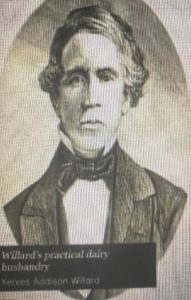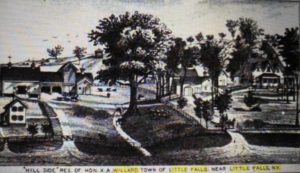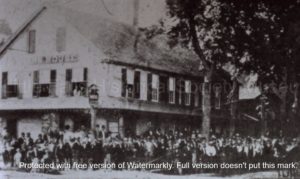2023 CHEESE FESTIVAL | OCTOBER 7th | 10 am – 5 pm
Home Of The First U.S. Open Air Cheese Market
Established 1861 at Little Falls, NY
Part I
This writing series article was first posted on the Little Falls Historical Society Museum website.
DID YOU KNOW…Xerxes Willard wrote articles on the activities of the cheese industry at Little Falls, for the Utica Morning Herald & Daily Gazette, which were read by cheese producers, buying agents and merchants, eventually leading to Little Falls becoming the hub for the Cheese Market?
From the Cooney Archives: This Day In History …” On the 27th of October in 1882, Xerxes A. Willard, the man responsible for making Little Falls the “cheese capital of our nation,” has died. He abandoned law as a career, became a farmer and was editor of the Herkimer County Journal, as well being an author on various phases of cheese making which became standards in the industry. He developed the method for establishing cheese prices and transmitting that information instantly across the country.”
XERXES SCHOOLS TO BECOME A LAWYER

Xerxes Willard
Xerxes Addison Willard was born in Eatonville, Herkimer County in 1820. His father was Dr Nathan Sylvester Willard, Sr, who was born at Saybrook, Conn in 1788, and died at Little Falls, on September 29, 1827. Dr. Willard could trace his family’s ancestry to Colonel Simon Willard, an English Puritan who settled in Boston in 1634. Xerxes Mother was Mary Wharry, who was the daughter of Judge Evans Wharry of Eatonville, NY. Mary died at Little Falls, on February 11, 1843.
Xerxes’ parents, Nathan and Mary, married on September 27, 1813, and he had four siblings, being Charlotte, Nathan Sylvester, Jr, Mary S., and Guliema Belknap. Xerxes studied law at Fairfield Academy and Cazenovia College, graduating in 1845 from Hamilton College. Before the year was over, he passed the bar exam and became employed as a lawyer in the office of Loomis and Nolton, at Little Falls.
XERXES’ FAMILY
In 1848, Xerxes married Harriet L. Hallett, from Fairfield, NY. They went on to have five children. His oldest child, Viola, married CFA Bielly, who was the rector for Buffalo’s St. Mary on the Hill Church. Next came Frank Almerin, who followed in his footsteps to Fairfield and Hamilton, becoming a lawyer, and working as an editor for the “Country Gentlemen.” He had two more sons, Addison, who stayed on the farm and Stephan, who became a dentist in Earlville, NY. His youngest being a daughter, Harriet, stayed on the farm with her brother, Addison.
THE FORMING OF CHEESE FACTORIES
By 1851, he was advocating for the ideas of his friend, Jesse Williams, for cheese farmers to become cooperative dairies to maximize their profits. Also, to form cheese factories, so they could produce a uniform outstanding American Cheddar Cheese. It equalized the supply of milk, cheese and butter presented to the market, with higher controlled pricing. Jesse Williams of Rome, New York, had the first Cheese Factory at “Highland Mills,” in 1851. Williams produced 100,000 pounds of cheese in his first year, from the milk of nearly 400 New York cows. Within fifteen years, there were over five-hundred cheese factories in New York State. Upon Williams’ death in 1864, Xerxes felt an educational scholarship would be better suited than a memorial to him, with Williams taking no patents or royalties on his inventions and improvements that he made in the cheese business. Williams wanted to share freely with anyone that was interested, his knowledge of cheese making. Williams was known as “The Father of Cheese Factories.” Herkimer County had nearly 100 cheese factories at the height of the cheese market in the 1860s.
HILL SIDE FARM

Hill Side Farm | Eatonville, NY | Present -day 173 Dise Road, with the property owned by Barbara Pelzer. He purchased the farm on June 1, 1858, for the sum of $1,220. His grandparents, Honorable Evans and Phebe Belknap Wharry, bought this land near Little Falls, NY in 1785.
In 1858, Xerxes gave up law and bought his maternal grandparents farm, “Hill Side Farm” in Eatonville, NY, which is present -day 173 Dise Road, with the property being owned by Barbara Pelzer. Willard purchased the farm on June 1, 1858, for the sum of $1,220. His grandparents, Honorable Evans and Phebe Belknap Wharry, bought this land near Little Falls, NY in 1785. Together, the Wharry’s cleared this land and built Hill Side Farm, remaining there throughout their lives. Here, Xerxes engaged in experiments on processing butter, cheese making, and dairying. Through trial and error, over a few years of dairying, he came to realize that one cow could easily produce 400 pounds of cheese yearly.
XERXES’ WRITINGS
Willard helped start the “Farmer’s Club” in Little Falls in 1857, holding the position of secretary for many years. He also acted as the spokesmen for the club through his essays and discussions on agriculture, with this club being one of the earliest of its kind in New York State. He combined his passion for writing and his growing knowledge of dairying, to hold the title of editor at the “Herkimer County Journal ” from 1858-1861. He also wrote for the New York State Agricultural Society of New York diaries. Xerxes wrote for the “Dairy Farmer,” a successful newspaper, along with Allen W. Eaton, who was the then present editor of the “Mohawk Courier,” at Little Falls in 1859. From 1860 through 1862, he worked for the Little Falls Canal, as a collector of tolls. In 1864, he became the editor of the “Utica Morning Herald,” running the agricultural section. For the Herald, he wrote of the activities of the cheese industry in Herkimer and Oneida Counties, promoting his hometown of Little Falls, which was read by cheese producers, buying agents and merchants. Xerxes’ articles eventually lead to Little Falls becoming the hub for the Cheese Market.
Willard’s services as a speaker were sought after around the country in the 1860’s. He published his first book in 1869, “Essays on Agriculture.” He also began writing articles in prominent periodicals, with one being the “New York State Agricultural Society.” Xerxes was the first American author to be invited to contribute articles to the “Journal of the Royal Agricultural Society of England.” In 1871, he published the book titled “A Treatise on American Butter Factories & Butter Manufacture.”
THE CHEESE TRADE AT LITTLE FALLS

The Evan’s House | Circa 1890s | Home of “The American Dairymen’s Association- Dairy Board of Trade ” in 1871 | Present-day location of the Valley Cinema, Corner of NY State Route 5 and South Ann Street, Little Falls, NY
Willard helped organize a cheese producers organization called “The American Dairymen’s Association, Dairy Board of Trade,” in 1871. He led as the association’s president for the first few years, with David H. Burrell of D. H. Burrell and Co., as its secretary. David’s father, Harry Burrell, started the trading of American Cheese in England in 1831, with a shipment of 10,000 pounds of cheese. The board started out with an office in the Chronkite Building and eventually moved their office to “The Evan’s House Hotel,” at the corner of Ann and Albany Street. This location is where the cheese farmers brought their products to market, with set cheese prices being established there. This pricing was telegraphed to New York City and England, with Little Falls becoming known as the Cheese Capital of the United States.
THE CHEDDARING OF CHEESE
The American Dairy Association sent Xerxes as a United States Representative to Europe, to dairies in England, France, Scotland, Ireland, and Switzerland. Not only did he study dairying, but he also studied the making of butter and cheese. On this trip, he met Joseph Harding, from Cheddar, in Somerset, England. There he became familiar with Harding’s cheddaring techniques of cheese making. Harding’s goal was to better preserve milk through expulsion of moisture and a tighter texture known to cheddar cheese and for it to be more dependable of aging without spoiling. When Xerxes got back to Little Falls, he popularized Harding’s cheddaring system of making cheddar cheese to better the quality of American Cheddar Cheese in the New York State cheese factories, with European Countries ordering directly from choice factory brands of these New York State cheese factories. Harding’s cheddaring was based on scientific principles, which started with absolute cleanliness and temperature control. Harding patented a “revolving breaker,” designed for the cutting of the milk curds, saving the dairymen considerable time and effort in the process of making cheese. Harding is known as “The Father of Cheddar Cheese.” Cheddar cheese has been made in England as far back as the year of 1170, with King Henry II having receipts of purchase.
WILLARD BECOMES AN AUTHOR OF BOOKS
In 1872, all the information that Willard gathered on his European Tour for the American Dairy Association, he authored into a 8 volume book series called “Practical Husbandry : A Complete Treatise on Dairy Farms and Farming, Dairy Stock and Stock Feeding, Milk, It’s Management and Manufacture Into Butter and Cheese-History Mode of Organization Of Butter, Butter and Cheese Factories” that was used worldwide as the standard reference for dairying.
He published in 1875, “Willard’s Practical Butter Book – A Complete Treatise on Butter Making at Factories and Far Dairies: Including the Selection, Feeding and Management of Stock For Butter Dairying- With Plans for Dairy rooms and Creameries, Dairy Fixtures, Utensils, Etc.”.
Willard spent his later years giving lectures along the east coast at agricultural schools and fairs, such as Cornell and Maine State Agricultural College.
Xerxes Addison Willard died of heart disease at Hillside Farm on October 26, 1882. The evening before he passed, he had spent his time writing a dairy article for the Encyclopedia Britannica.
*Digitizing of Historical Photos by Gail & Mike Potter, FROM THE COONEY ARCHIVES: THIS DAY IN HISTORY by Louis Baum, JR, and article written by Darlene Smith
LAST WEEK FOR FREE TOURS of the Little Falls Historical Society Museum. The museum will be open this week leading up to the Cheese Fest for FREE TOURS on Monday, Wednesday, and Friday from 1 pm-4 pm, and on CHEESE FEST DAY Saturday, which will be our last day for the season, we will be open from 10am – 4pm. We will be accepting “Appointments for After Hours” for this week-for an appointment, please contact Louis Baum at 315-867-3527. Please stop in for a visit!

 The Mayfield Historical Society's Fall Harvest Cruise-In
The Mayfield Historical Society's Fall Harvest Cruise-In